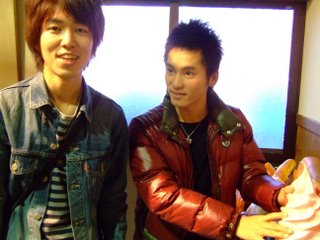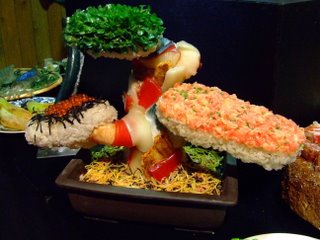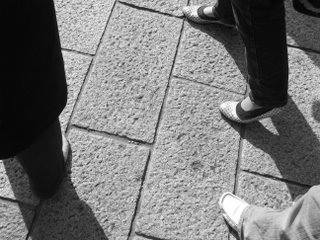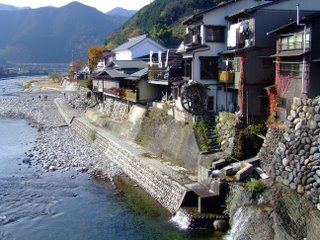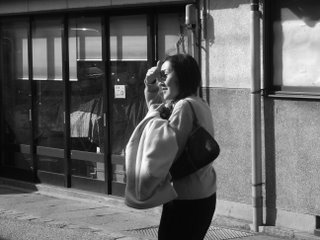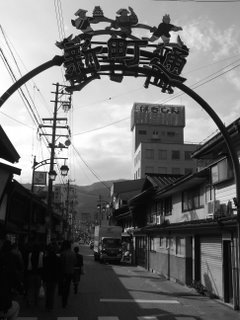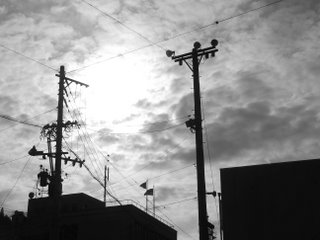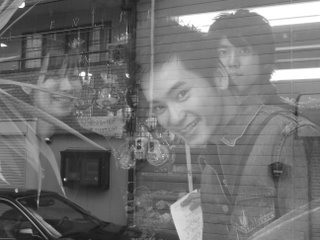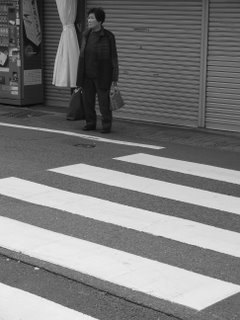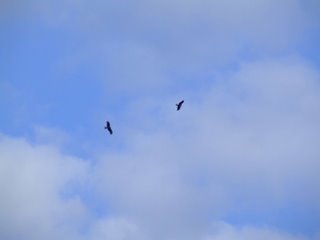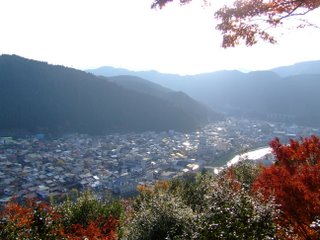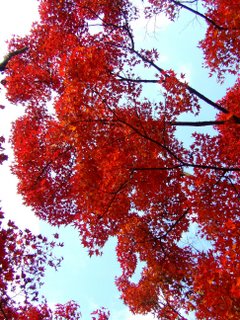It's been awhile
Life has been moving, fast.
Since that one weekend in November, people have come and gone, stories and dramas have developed and dissipated. More and more I appreciate my time remaining in Japan - the people I know, the beautiful beautiful and amazing people I have met here. That is what I feel most fortunate about with this experience, the opportunities I've been given to meet and make some life-altering friends.
When I think about Japan, as a country or as a feeling or concept, my thoughts immediately sway towards Shikoku. One of my best friends, David, lives there along with a group of people who make you cry when you think about them because they are just that good. I want to go back and visit Shikoku, at least once before I leave here.
So much has happened. I wonder what tone this blog should take. I've introduced more and more personal things into this little space, so I figure I'll use it that way from now on. If it's boring, I've no doubt you'll know what to do.
One reason for avoiding this blogspace lately is because the way "blogger" updated its web software. I was crushed to discover that some of my photos cannot be uploaded to this blog with the alignment I want. It sounds small, but it's not. The matter is difficult to explain, but I apologize that some pictures will not be aligned properly. I've tried several things to try to fix it, but it appears the problem is in the way blogger's software reads the data from my computer when uploading a picture. But if anyone has had this problem and found a solution, please let me know!

These are pictures from Christmas in Kyoto. I met David, his older sister and one of his cousins. It was the first time for me to go to Kyoto. There is nothing that can really prepare one for the overload of sights there are to be seen in Kyoto. The city itself is quite large, but the density of number of world heritage sites (it almost became a joke because just about every old historic building has a 'designated world heritage site' sign in front of it) is dizzying. It is impossible to see all there is to see in Kyoto.

The Kyoto skyline, taken from a veranda at Kyomizudera Temple (see later picture). As you can see, Kyoto as a city, really doesn't look like anything special. In fact, some have said Kyoto has a particularly unappetizing skyline, due to its weird mix of large and incongruent reinforced concrete structures (Kyoto tower on the right side) with a large number of older, dilapidated areas. In other words, the joy of Kyoto is not to be had by gazing over it from the master eye of an architect, but to enjoy its details while crawling like an ant through the mazes of its back-streets and small neighborhood boroughs where old men and women carry on as they have been for many many years.

Every year in Japan, a group decides on a kanji that best represents the tone or character of the year. This happens around the end of December, amidst the anticipation of the new year and the reflections over the previous year. The kanji of 2006 is this one above. It means life. I heard the reasons for choosing this kanji were mostly due to a few child suicides in 2006 as a result of school bullying. In Japanese class we read a few newspaper articles about this, and in one they had excerpts from a 12 year old girl's suicide note. She said she was unable to cope any longer with the abuse. Her parents did not know she was being bullied. Her father said she was too serious and always studied, always tried to take care of everything on her own. In response to these events, and a fear that Japan's population is diminishing with fewer and fewer people having children every year, this kanji was chosen to remind people that life is precious, it should be guarded and protected, and in Japan's case, to encourage more people to have babies.


Looking at Kyomizudera - one of Kyoto's most famous sites. It is a Buddhist temple, with a gorgeous alter inside. It was fun feeling the anxiousness and slight irritation of myself and others waiting to step up into the alter area, while at the same time taking care that one's shoes were properly and neatly turned in the right direction, and lined up with everyone else's. Then scuttling along in your socks on the cold wooden floor of the raised alter platform, this curious mix of tourists, believers, and all types of shades of people in between threw money into the main offering box, hit one of the largest singing bowls I have ever seen, and posed for pictures. Going to a famous temple in Japan is not relaxing by any means.


This water fountain was located in the Kyomizudera temple complex. I heard if you drink this water it gives you good health and a long life. Alot of temples in Japan have this type of setup. People will bring plastic water bottles, fill them up to take back home or give as gifts. I think because I am from the US, and we don't have this tradition, it's really hard for me to feel comfortable drinking water from the ground. All I can think about are worms, parasites and bacteria eating me alive. Even so, I still like to drink when the lines aren't too long.


As mentioned before, the joy of Kyoto is really in walking around its small streets and seeing little pockets of an old old local life. I stood in front of an old Tofu store and watched a husband and wife prepare tofu for the day. The man was busy making Agedofu, or friend tofu, while the wife moved large blocks of tofu yet to be cut into smaller sections to sell. Later on, I would see a tofu store's carriage, resting on the ground without its driver. Many people used to buy tofu from these men, who pulled carts filled with tofu and either rang bells or yelled out to alert potential customers that tofu was on its merry way to their stomachs. Just like the icecream trucks in the US. Now most people probably buy tofu at the supermarket, but you can still go to a Tofu-ya, or Tofu-yasan, a shop that specializes in all things tofu. This picture above was a general vegetable shop, but it has the same feel.

No matter where I've been in Japan, from Hokkaido to Shikoku, this scene is common. The same materials used to build the same style of warehouse or factory, with the same weathered rust growth, combined with the crosswalk that uses the image of a salary-man with a hat. I've fallen in love with this side of Japan, and feel more at home next to these buildings than I do the new, shiny glassy chic Shibuya bubbles that you can find in the larger cities in Japan.

I really put these next few pictures up for my pops, because I knew he would get a kick out of seeing some amazing tree training. In the garden of Ryoanji Temple, this small patch of trees stands in monument to the incredible patience and dedication that is required to create trees that look like this.

This is a close-up of a base of one of the trees in the previous picture. You can see how many leaders were cut back, in order to create the effect of a single, bare trunk.

I've spent a lot of time out in the backyard of our backyard with my Pops, constructing braces and other forms of support for sagging trees. This example here, a simple triangle base, is pretty simple, but its scale is mind-boggling. Just try to imagine the planning, the construction, and the installation of that...

I thought this was a really good idea, although its aesthetic quality is not as nice as other forms of support I've seen. The idea is simple, a single pole that is centered alongside the trunk of the tree. From that pole extend supporting rope to branches too heavy for their own good, or that need directional training.

This is the legendary Kinkakuji, or the Golden Pavilion. The outside is gilded. It really is a shame I can't figure out a way to upload this picture so that it is vertically aligned. We happened to enter the large garden area where this pond is located late in the afternoon, which produced a nice sun-angle and struck the pavilion creating a warm glow. It was beautiful to share this experience with David and his family, and one of my favorite moments in Kyoto.

Sanjusangendo is this deceivingly small looking hall/temple that is filled with 1000 statues of Kanon. There are 999 life-size statues of Kanon flanking both the left and right side of the main statue, a much much larger Kanon. No pictures were allowed inside, which is a damn shame because it is incredible. This place is for East Asian Art Historians studying Japanese art one of Japan's most beautifully preserved and astounding examples of the skill achieved in fine craftsmanship. Also, it is quite an experience to stand in this hall, looking down its long stretches at row after row of these life-size Kanon statues, each one slightly different, with different facial features. As a Buddhist it was a tad bit overwhelming for me, I've never been face to face with so much statuary in one place at one time. I tend to watch the monks working the gift shop to see how strict the monastic training is, and the monks here were some of the lightest beings I've seen in Japan. At least what I can tell from my poor perception.

Earlier I talked about Ryoanji in the context of the tree training photos, but this is the main gem of Ryoanji Temple: perhaps the world's most famous Zen rock garden.
This garden is probably photographed more often, and used as the defining example as the ideal model for the Zen rock garden aesthetic than any other in Japan.
It was great to sit on this veranda, with other tourists, who knows where from, and all enjoy together the strange and bizarre sense of space looking at this garden makes you feel. There was a natural hush that came over everyone as soon as their eyes set foot on the sturdy wood beams. As if our voices were going to hurt the rock's ears....
It's difficult to explain the feeling, the light was soft that moment, and the people there were too. Everyone it seemed had some idea of meaning for this experience, and no matter how different or deep their meanings were, everyone was able to appreciate the view.

This is the border of the rock garden.

Inside the gift shop area, the man below was warmed by this portable heater. Since there are very few places in Japan with central heating, these heaters are used in businesses, homes, even on public transportation sometimes. This is the heat of Japan when it's cold.

This man is writing the calligraphy for some protection amulets and prayers sold at Ryoanji Temple.
Since that one weekend in November, people have come and gone, stories and dramas have developed and dissipated. More and more I appreciate my time remaining in Japan - the people I know, the beautiful beautiful and amazing people I have met here. That is what I feel most fortunate about with this experience, the opportunities I've been given to meet and make some life-altering friends.
When I think about Japan, as a country or as a feeling or concept, my thoughts immediately sway towards Shikoku. One of my best friends, David, lives there along with a group of people who make you cry when you think about them because they are just that good. I want to go back and visit Shikoku, at least once before I leave here.
So much has happened. I wonder what tone this blog should take. I've introduced more and more personal things into this little space, so I figure I'll use it that way from now on. If it's boring, I've no doubt you'll know what to do.
One reason for avoiding this blogspace lately is because the way "blogger" updated its web software. I was crushed to discover that some of my photos cannot be uploaded to this blog with the alignment I want. It sounds small, but it's not. The matter is difficult to explain, but I apologize that some pictures will not be aligned properly. I've tried several things to try to fix it, but it appears the problem is in the way blogger's software reads the data from my computer when uploading a picture. But if anyone has had this problem and found a solution, please let me know!

These are pictures from Christmas in Kyoto. I met David, his older sister and one of his cousins. It was the first time for me to go to Kyoto. There is nothing that can really prepare one for the overload of sights there are to be seen in Kyoto. The city itself is quite large, but the density of number of world heritage sites (it almost became a joke because just about every old historic building has a 'designated world heritage site' sign in front of it) is dizzying. It is impossible to see all there is to see in Kyoto.

The Kyoto skyline, taken from a veranda at Kyomizudera Temple (see later picture). As you can see, Kyoto as a city, really doesn't look like anything special. In fact, some have said Kyoto has a particularly unappetizing skyline, due to its weird mix of large and incongruent reinforced concrete structures (Kyoto tower on the right side) with a large number of older, dilapidated areas. In other words, the joy of Kyoto is not to be had by gazing over it from the master eye of an architect, but to enjoy its details while crawling like an ant through the mazes of its back-streets and small neighborhood boroughs where old men and women carry on as they have been for many many years.

Every year in Japan, a group decides on a kanji that best represents the tone or character of the year. This happens around the end of December, amidst the anticipation of the new year and the reflections over the previous year. The kanji of 2006 is this one above. It means life. I heard the reasons for choosing this kanji were mostly due to a few child suicides in 2006 as a result of school bullying. In Japanese class we read a few newspaper articles about this, and in one they had excerpts from a 12 year old girl's suicide note. She said she was unable to cope any longer with the abuse. Her parents did not know she was being bullied. Her father said she was too serious and always studied, always tried to take care of everything on her own. In response to these events, and a fear that Japan's population is diminishing with fewer and fewer people having children every year, this kanji was chosen to remind people that life is precious, it should be guarded and protected, and in Japan's case, to encourage more people to have babies.


Looking at Kyomizudera - one of Kyoto's most famous sites. It is a Buddhist temple, with a gorgeous alter inside. It was fun feeling the anxiousness and slight irritation of myself and others waiting to step up into the alter area, while at the same time taking care that one's shoes were properly and neatly turned in the right direction, and lined up with everyone else's. Then scuttling along in your socks on the cold wooden floor of the raised alter platform, this curious mix of tourists, believers, and all types of shades of people in between threw money into the main offering box, hit one of the largest singing bowls I have ever seen, and posed for pictures. Going to a famous temple in Japan is not relaxing by any means.


This water fountain was located in the Kyomizudera temple complex. I heard if you drink this water it gives you good health and a long life. Alot of temples in Japan have this type of setup. People will bring plastic water bottles, fill them up to take back home or give as gifts. I think because I am from the US, and we don't have this tradition, it's really hard for me to feel comfortable drinking water from the ground. All I can think about are worms, parasites and bacteria eating me alive. Even so, I still like to drink when the lines aren't too long.


As mentioned before, the joy of Kyoto is really in walking around its small streets and seeing little pockets of an old old local life. I stood in front of an old Tofu store and watched a husband and wife prepare tofu for the day. The man was busy making Agedofu, or friend tofu, while the wife moved large blocks of tofu yet to be cut into smaller sections to sell. Later on, I would see a tofu store's carriage, resting on the ground without its driver. Many people used to buy tofu from these men, who pulled carts filled with tofu and either rang bells or yelled out to alert potential customers that tofu was on its merry way to their stomachs. Just like the icecream trucks in the US. Now most people probably buy tofu at the supermarket, but you can still go to a Tofu-ya, or Tofu-yasan, a shop that specializes in all things tofu. This picture above was a general vegetable shop, but it has the same feel.

No matter where I've been in Japan, from Hokkaido to Shikoku, this scene is common. The same materials used to build the same style of warehouse or factory, with the same weathered rust growth, combined with the crosswalk that uses the image of a salary-man with a hat. I've fallen in love with this side of Japan, and feel more at home next to these buildings than I do the new, shiny glassy chic Shibuya bubbles that you can find in the larger cities in Japan.

I really put these next few pictures up for my pops, because I knew he would get a kick out of seeing some amazing tree training. In the garden of Ryoanji Temple, this small patch of trees stands in monument to the incredible patience and dedication that is required to create trees that look like this.

This is a close-up of a base of one of the trees in the previous picture. You can see how many leaders were cut back, in order to create the effect of a single, bare trunk.

I've spent a lot of time out in the backyard of our backyard with my Pops, constructing braces and other forms of support for sagging trees. This example here, a simple triangle base, is pretty simple, but its scale is mind-boggling. Just try to imagine the planning, the construction, and the installation of that...

I thought this was a really good idea, although its aesthetic quality is not as nice as other forms of support I've seen. The idea is simple, a single pole that is centered alongside the trunk of the tree. From that pole extend supporting rope to branches too heavy for their own good, or that need directional training.

This is the legendary Kinkakuji, or the Golden Pavilion. The outside is gilded. It really is a shame I can't figure out a way to upload this picture so that it is vertically aligned. We happened to enter the large garden area where this pond is located late in the afternoon, which produced a nice sun-angle and struck the pavilion creating a warm glow. It was beautiful to share this experience with David and his family, and one of my favorite moments in Kyoto.

Sanjusangendo is this deceivingly small looking hall/temple that is filled with 1000 statues of Kanon. There are 999 life-size statues of Kanon flanking both the left and right side of the main statue, a much much larger Kanon. No pictures were allowed inside, which is a damn shame because it is incredible. This place is for East Asian Art Historians studying Japanese art one of Japan's most beautifully preserved and astounding examples of the skill achieved in fine craftsmanship. Also, it is quite an experience to stand in this hall, looking down its long stretches at row after row of these life-size Kanon statues, each one slightly different, with different facial features. As a Buddhist it was a tad bit overwhelming for me, I've never been face to face with so much statuary in one place at one time. I tend to watch the monks working the gift shop to see how strict the monastic training is, and the monks here were some of the lightest beings I've seen in Japan. At least what I can tell from my poor perception.

Earlier I talked about Ryoanji in the context of the tree training photos, but this is the main gem of Ryoanji Temple: perhaps the world's most famous Zen rock garden.
This garden is probably photographed more often, and used as the defining example as the ideal model for the Zen rock garden aesthetic than any other in Japan.
It was great to sit on this veranda, with other tourists, who knows where from, and all enjoy together the strange and bizarre sense of space looking at this garden makes you feel. There was a natural hush that came over everyone as soon as their eyes set foot on the sturdy wood beams. As if our voices were going to hurt the rock's ears....
It's difficult to explain the feeling, the light was soft that moment, and the people there were too. Everyone it seemed had some idea of meaning for this experience, and no matter how different or deep their meanings were, everyone was able to appreciate the view.

This is the border of the rock garden.

Inside the gift shop area, the man below was warmed by this portable heater. Since there are very few places in Japan with central heating, these heaters are used in businesses, homes, even on public transportation sometimes. This is the heat of Japan when it's cold.

This man is writing the calligraphy for some protection amulets and prayers sold at Ryoanji Temple.
